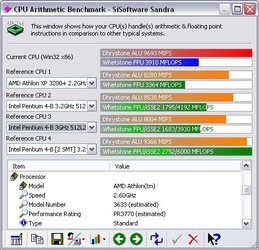Sniper.nkc said:
Which is better, L12 MOD or increasing FSB? I want higher score on benchmarks.
Short answer: Higher FSB is better for performance, mainly for memory bandwidth between the memory controller (in NB) and CPU for XP motherboards. L12 is just a
potential mean (may or may not work) to achieve that.
If aiming for only high overclocking of an (multiplier) unlocked CPU, FSB and potential L12 mod would NOT help CPU overclocking. FSB and CPU frequency are independent parameters (at leat to first degree).
If you have an unlocked XP CPU such as a mobile Barton or an early Tbred B/Barton (older than week 0338 or so), then higher FSB and higher CPU frequency can be achieved
at the same time by appropiately setting the CPU multiplier
CPU_frequency = CPU_multiplier x FSB
So higher FSB is better provided the motherboard, in particular the North Bridge and its memory controller, and the memory allow such FSB overclocking. One may need to improve chipset cooling (SB, and NB in particular) and give enough Vdimm to memory (not uncommon to use 2.9-3.0 V for BH5, CH5 memory chips) to achieve that.
For nforce2 rev 2.0 (aka 400 Ultra) motherboards, such as NF7-S rev 2.0, there is a good chance to overclock the FSB to 200 - 230 MHz without extensive mod (chipset cooling and Vdimm).
There are certain NF7-S rev 2.0 (not every board) whose FSB overclocking can be greatly facilitated by the so called "L12 mod" which alters the CPU default FSB_sense[0] and FSB_sense[1] signals from 133 MHz to either 166 MHz or 200 MHz.
I personally tried on two NF7-S rev 2.0, one board improved by 10-15+ MHz on FSB (from 215 to 225-230 MHz), and one board did not at all (0 MHz, but that board does 227 MHz with stock everything).
Ref:
FSB_Sense mod to set Tbred B default FSB from 133 to 166 (page 12)
FSB_Sense mod to set Tbred B default FSB from 133 to 200 (page 12)
NF7-S rev 2.0 FSB_Sense 166 and 200 mod (from 133) test results (page 12)
NF7-S rev 2.0 FSB_Sense 166 and 200 mod (from 133) test results (part 2) (page 12)
Summary on overclocking the NF7-S rev 2.0 (with Tbred B 1700+ DLT3C and ...) (page 15)



